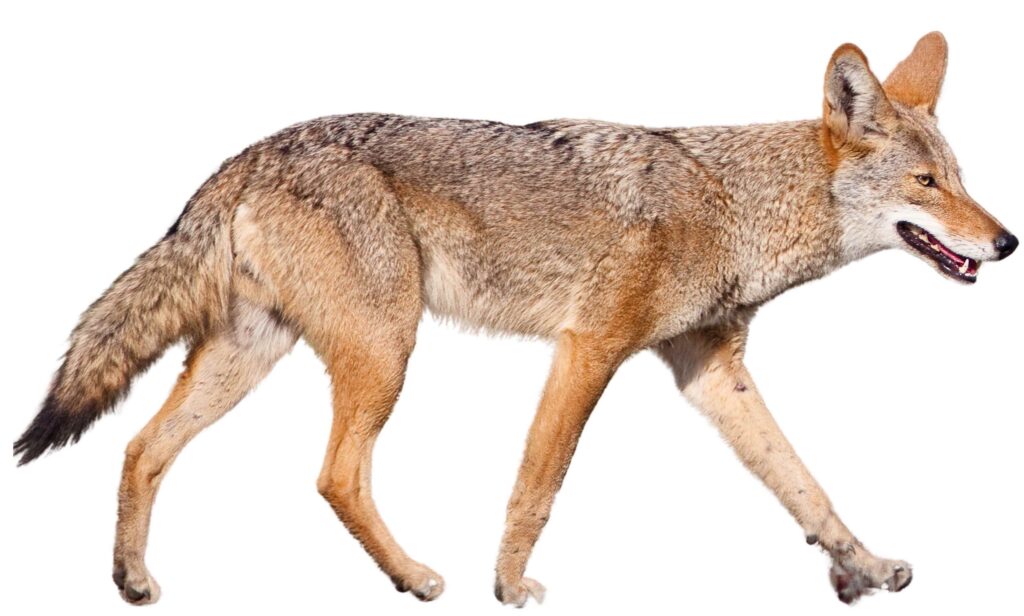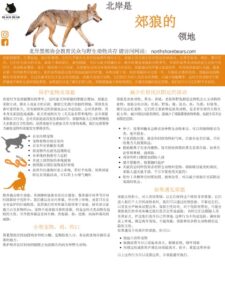
Coyotes are intelligent, family oriented and incredibly adaptable; they can survive in almost any terrestrial environment in North America. Coyotes live, play, rest and raise their young in the green spaces around our neighbourhoods. They can be distinguished from domestic dogs by their large, pointed ears, bushy, downward-pointed tails, and yellow eyes. Coyotes are active year-round. They are typically more visible in late winter during mating season and in the late spring and summer months when the family is busy teaching new offspring survival skills. An average of 6 pups are born inside a den in the spring, though the number of pups can vary widely depending on what their environment can support. Coyotes use vocalizations to bond with their family and to communicate with other coyotes. Dispersal of juvenile coyotes begins during their first fall. At this time of year, some young coyotes will leave home to live independently, whilst others will remain with their family. Many coyotes will not survive their first year, with vehicle collisions being the primary cause of death. Coyotes are most active between dusk and dawn; however, daytime activity in urban areas is not uncommon. Coyotes are not nocturnal; they have adapted their behaviour to minimize encounters with humans. These canines play a vital role in maintaining a healthy and balanced ecosystem. Coexisting with coyotes is possible if we make efforts to learn about their behaviour, take steps to minimize food opportunities and set boundaries during encounters.
HELP TO REDUCE ACTIVITY CLOSE TO HOMES
From fruit to frogs and rats to rabbits, these opportunistic omnivores eat most things. Coyotes eat mice, squirrels, hares, deer, insects, fish, eggs, garbage, and occasionally, pets. Much of their diet is rodents, making them a great natural pest control. By managing rodent attractants on your property, you reduce important food sources for coyotes and their reason for staying close to homes.
- Seeds, nuts, and suet bring a variety of wildlife into the neighbourhood. Instead, plant to encourage birds. Never intentionally feed any wildlife
- Keep garbage, organics, and recycling as odour free as possible. Keep in a secure area until morning of collection
- Pick fruit early and allow to ripen indoors. Collect fallen fruit daily and store in a secure area. If you cannot commit to managing fruit trees, please remove them
- Secure chickens and livestock
- Raise cats indoors and supervise dogs on your property
- Wildlife and pets are suffering and dying from rodenticides. Remove rodent attractants or use humane methods. Never use poison!
- Secure spaces under decks/sheds and clear overgrown areas often to reduce denning opportunities on your property
HELP TO KEEP PETS AND COYOTES SAFE
Encounters between coyotes and domestic dogs typically increase in the spring and summer months when the coyote family is responsible for raising young. During this time, coyotes are more assertive and may follow you and your dog to push you away from an area. Your dog, however friendly and playful, will be seen as a risk to coyotes who are not domesticated. To a coyote, your dog is a threat to food, their safety, and their family. Pressure from dogs (especially those off-leash) can cause defensive behaviour from coyotes, who may signal to their family for help. Most encounters between coyotes and our family dogs are defensive in nature. It is not common for coyotes to seek dogs as a food source, but efforts should be made to protect both pets and coyotes from injury.
- Feed pets inside
- Store excess pet food securely indoors
- Install lighting outside your home
- Scan your property before allowing pets outside
- Supervise dogs closely if off-leash around your home
- Keep dogs on a close leash on trails
- Always leash pets if signage indicates to do so
- Leash your dog and carry a flashlight if you are anywhere outside with your dog between dusk and dawn. Carry a small airhorn if you live in an area with lots of coyote activity
Outdoor cats encourage coyotes, cougars, and birds of prey to seek opportunities close to our homes. Roaming cats are vulnerable year-round, at any time of day or night. We encourage raising cats indoors with outdoor time on a harness or in a supervised and secure outdoor area. Whilst coyotes receive much of the blame for missing cats, studies have shown that domestic pets make up less than 2% of their diet. Pets are not a reliable food source, but these canines have a natural chase instinct. Outdoor cats are at higher risk from vehicles, other cats, dogs, raccoons, disease, and poisons.
SMALL PETS, CHICKENS, LIVESTOCK
Ensure enclosures are sturdy and secure with heavy mesh wire. Regularly check for access points. Store excess food in a secure location. Properly maintained electric fencing will help to deter an array of wildlife, including bears.
IF YOU ENCOUNTER A COYOTE
Coyotes are naturally timid and wary of people. It is important that we encourage them to remain that way. We can set clear boundaries by never intentionally feeding or approaching them and by communicating when they enter our personal space or property. Coyotes are curious animals who are alert to threats and may observe your movements to ensure you are not a danger. Coyotes may follow you and your dog to escort you away from their area – this is not aggressive behaviour. Ensure your dog is leashed and calmly leave the area. Coyotes, and many other wild animals, have a natural chase instinct and it is important not to run.
If you have a close encounter and the coyote does not leave:
- Pick up small children and pets
- Intimidate the coyote by making yourself look big and maintaining eye contact
- Use a firm, assertive tone and tell the coyote to leave. Clap your hands and be persistent
Using these methods to set boundaries will teach coyotes to avoid us.


